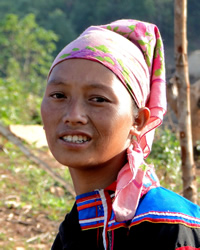Wa in Thailand
|
Send Joshua Project a map of this people group.
|
| People Name: | Wa |
| Country: | Thailand |
| 10/40 Window: | Yes |
| Population: | 7,100 |
| World Population: | 848,100 |
| Primary Language: | Wa, Parauk |
| Primary Religion: | Ethnic Religions |
| Christian Adherents: | 30.00 % |
| Evangelicals: | 15.00 % |
| Scripture: | Complete Bible |
| Ministry Resources: | Yes |
| Jesus Film: | No |
| Audio Recordings: | No |
| People Cluster: | Mon-Khmer |
| Affinity Bloc: | Southeast Asian Peoples |
| Progress Level: |
|
Introduction / History
The Wa are one of the most prominent groups in southern China, but they also live in Myanmar and Thailand. The name Wa means "mountaineer."
In recent times some Wa communities from Burma have crossed the border and settled in Thailand, where they have no official status as a Hill Tribe. The Wa live mainly in the Mae Sai District and Mae Yao subdistrict of Chiang Rai Province, as well as in Wiang Pa Pao District in southern Chiang Rai Province and Chiang Dao District in Chiang Mai Province. In Thailand they are often referred to as 'Lawa', although they do not strictly belong to the latter ethnic subgroup.
For centuries, the Wa engaged in head-hunting for the purpose of ensuring a good harvest. The practice is still rumored to continue in remote parts of Myanmar's Shan State. The evil spirits that control the Wa demanded human sacrifice to guarantee a good crop. In 1962 a Wa man from Daigela Village cut off a person's head by mistake while working in the fields. The victim's village retaliated by cutting off the heads of more than 60 people from Daigela. In the past, incidents like this often sparked a sequence of killings that would continue for generations. The Wa have an expression, "There is no sight so beautiful as the three-pronged fork" - referring to the poles in their villages that they used to hang the heads of their victims on.
What Are Their Lives Like?
The Wa people have often been involved in the opium trade.
What Are Their Beliefs?
Almost half identify as Christians, and there are Bible-believing Christians among them. They have a complete Bible and many evangelistic tools. However, ethnic religion has a hold on them because it is tied in with their identity.
What Are Their Needs?
Hlengwes need the Holy Spirit's powerful work to permeate their hearts and church life. Many Christians in southern Africa have a vibrant prayer life and are filled with worship. They need God's clear calling to go to the lost.
Prayer Points
Pray for the gospel to penetrate the rural Thailand and reach Wa families.
Pray for the Lord to show himself to be powerful and good to the Wa people.
Pray that soon there will be Wa disciples who take Christ to the Buddhists in Thailand.
